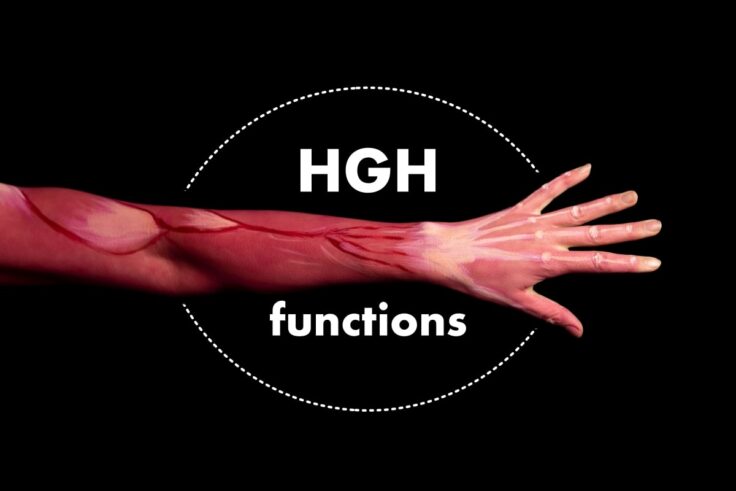8 Functions Of The Human Growth Hormone In The Body

Human growth hormone functions include regulating body composition, body fluids, muscle and bone growth, sugar and fat metabolism, and more.
As its name might suggest, the human growth hormone (HGH) is a chemical messenger responsible for growth. It also controls cell regeneration and reproduction.
This hormone occurs naturally in our bodies and is produced by the pituitary gland located at the base of our brains.
Now, since it’s a natural process, there are cases when the amount of HGH produced is insufficient. This is a condition called growth hormone deficiency, which can be treated safely and effectively with growth hormone therapy.
Hormone replacement therapy is also used frequently to treat low testosterone levels in men and menopause symptoms in women.
Now let’s take a look over the human growth hormone functions and their impact on fitness, training, and athletic performance.
Human Growth Hormone Functions
Here are the most important functions of the growth hormone that impact your training:
1. Decreases Glucose Utilization
The first thing we’re going to think about with growth hormone is that it’s gonna decrease our utilization of glucose. Now, why is that?
Let’s think about the example of you eating a meal and then you falling asleep and your growth hormones increasing. We know growth hormone increases at night, so what’s gonna happen?
That’s going to cause a mobilization of fat into the bloodstream which basically is gonna decrease our reliance on glucose as a fuel source.
So anytime the growth hormone increases, we don’t have to use glucose quite as much.
2. Decreases Glycogen Synthesis
Glycogen is just a polymer of glucose. It’s just the short-term storage of glucose in our muscles and in our liver. So glycogen is formed by basically just a combination of a bunch of glucose molecules.
So when we think about glycogen it basically has an anti-insulin effect, meaning it doesn’t allow insulin to do its job of storing glucose as glycogen.
3. Increases IGF-1 Release
When we think of the role of hormones overall, they’re flowing around in the bloodstream and basically telling other things what to do.
So we think about growth hormone that it’s released in the anterior pituitary gland, it flows around in the bloodstream, and then, and whenever the liver picks it up, it stimulates the release of IGF-1 (insulin-like growth factor-1).
4. Increases Amino Acid Transport And Muscle Protein Synthesis
That release of insulin-like growth factor-1 can stimulate amino acid transporting for improvements as well as increases in muscle protein synthesis.
Basically, you can think of it as providing a situation that’s most optimal for promoting muscle protein synthesis, cell repair, and tissue growth.
5. Promotes Lipolysis And Fatty Acid Utilization
Lipolysis is basically the breakdown of a glycerol backbone off of the fatty acid chain.
So if we think about an adipocyte stored fat (a big stored fat molecule), we have a glycerol backbone and then some fatty acid chains. If we break the fatty acid chain off the glycerol, that fatty acid chain can leave the adipocyte and it can go and break down to be used for energy.
So growth hormone actually promotes that process of lipolysis and then fatty acid utilization.
6. Promotes Collagen Synthesis And Cartilage Growth
These are both promoted by an increasing level of growth hormone. So collagen and cartilage are important for things like tendons, ligaments, and joint structures.
And again, growth hormone is a molecule that, in the bloodstream, promotes an environment that facilitates tissue, collagen, and cartilage growth.
7. Increases Immune Cell Function
An increase in growth hormone in the bloodstream helps with immune cell functioning. This is because as growth hormone moves throughout the bloodstream it’s going to stimulate releases of other cells like t-cells, b-cells, and cytokines.
These cells are related to processes such as inflammation and repair within the immune cell.
8. Regulates The Electrolytes
Our last function of growth hormone is actually the regulation of the level of electrolytes, things like nitrogen, sodium, potassium, and phosphorus.
Basically, growth hormone has an effect on the renin-angiotensin system which regulates the electrolyte balance and the water balance within our body.
So when we increase growth hormone, that regulation is going to promote the storage or the maintenance of the electrolytes that we have. This leads to the promotion of an overall tissue growth environment.
The Takeaway
A hormone is something that floats around in the bloodstream and communicates between different cells and organs.
HGH is a hormone that does all of these different functions:
- Decreases our reliance on glucose;
- Stimulates IGF-1;
- Increases amino acid transport;
- Helps promote muscle protein synthesis;
- Breaks down fats and moves them out into the bloodstream to use them for energy;
- Promotes collagen synthesis, cartilage growth, immune cell function, and the retention of electrolytes.
Hopefully, this has been helpful in improving your understanding of the human growth hormone functions inside our bodies.
If you want, you can read more about the human growth hormone’s impact on weight loss and muscle building in this article.